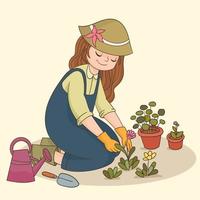New to Gardening? Open the Keys with our Newbie Gardening Tips
Wiki Article
From Amateur to Eco-friendly Thumb: A Step-by-Step Trip Through the Art of Horticulture

Understanding Your Horticulture Room
To start your gardening journey, it is crucial to recognize the unique qualities and limitations of your horticulture space. Are there any type of particular difficulties you may deal with, such as inadequate dirt top quality or restricted water schedule? Understanding these elements will certainly help you make educated choices about the kinds of plants that will certainly prosper in your room.Think about the size of your gardening location. If you have a small space, you might require to focus on container horticulture or upright horticulture to maximize your growing area. On the other hand, if you have a big area, you have the deluxe of growing a variety of plants and producing various areas within your yard.
If your room is shaded, you can decide for shade-loving plants like hostas or ferns (newbie gardening). If your space receives complete sunlight, you can expand a broad variety of plants, consisting of vegetables, blossoms, and natural herbs.
Finally, consider any obstacles or restrictions particular to your space. If your soil high quality is poor, you might require to amend it with garden compost or select plants that are forgiving of less-than-ideal problems. If water is limited, you can opt for drought-tolerant plants or apply water-saving methods like mulching.
Selecting the Right Plants for Your Yard
Select plants that are fit to your yard's distinct problems and your individual preferences. When selecting plants for your yard, it is important to think about aspects such as sunshine, soil type, and climate. Some plants prefer well-drained soil, while others grow in clay-like or moist soil.It's likewise worth taking into consideration the maintenance degree of the plants you pick. Some plants need even more care and interest, while others are more low-maintenance.
Preparing the Soil for Growing
First, assess the problem of your dirt to figure out if any enhancements or changes are required. The high quality of your soil is important for the success of your garden. Beginning by examining the structure of the soil. Is it sandy, loamy, or clayey? Sandy dirt drains pipes rapidly, while clayey soil retains water. Loamy dirt is the excellent equilibrium between the two. Next, examine the pH degree of your dirt. The majority of plants like a slightly acidic to neutral pH, around 6.0 to 7.0. You may need to readjust it making use of soil amendments such as lime or sulfur if your soil is also acidic or alkaline. Furthermore, you must think about the nutrient web content of your soil. If any type of important nutrients are doing not have, Conduct a soil test to establish. This will certainly help you determine which fertilizers or natural matter to include. Make certain that your soil is well-draining. Inadequately drained dirt can result in water logged roots and various other plant health concerns. If required, boost drainage by adding organic issue like compost or peat moss. By examining and making necessary changes to your dirt, you can create an ideal environment for your plants to prosper.Nurturing and Keeping Your Garden
Make certain to water your plants deeply, permitting the water to permeate the soil and reach the origins. Normal weeding is likewise essential to maintain your garden cost-free from unwanted plants that complete for nutrients and space. Routinely evaluate your plants for any type of indicators of invasion or ailment and take immediate activity to avoid more damage.Troubleshooting Common Horticulture Issues
If you notice eaten leaves or plants that are wilting for no noticeable factor, you may have a pest problem. If your plants have yellow or discolored fallen leaves, they may not be obtaining sufficient nutrients. Remove influenced plants this post and treat the continuing to be ones with natural fungicides or pesticides.Conclusion
Congratulations! You have actually successfully finished the trip from beginner to environment-friendly thumb in the art of gardening. By understanding your gardening area, picking the right plants, preparing the soil, and supporting your yard, check over here you have conquered usual gardening problems like a pro. Currently, armed with understanding and experience, you prepare to enjoy the charm and wealth of your thriving garden. Maintain the great work and remain to grow your green thumb!
When choosing plants for your yard, it is crucial to think about factors such as sunshine, soil kind, and environment. Some plants click for more info choose well-drained dirt, while others prosper in clay-like or moist dirt (newbie gardening). By understanding your horticulture area, choosing the right plants, preparing the dirt, and nurturing your garden, you have actually conquered usual gardening concerns like a pro
Report this wiki page